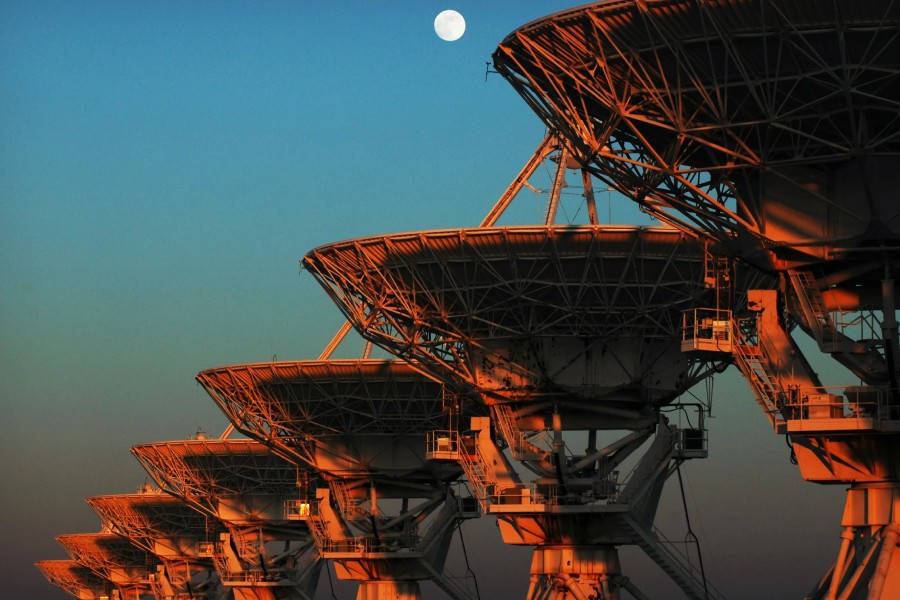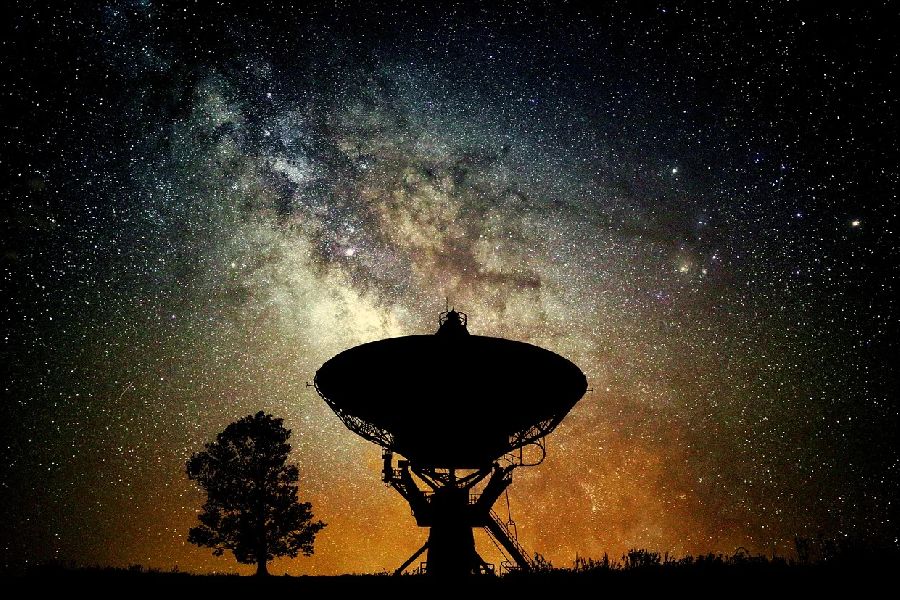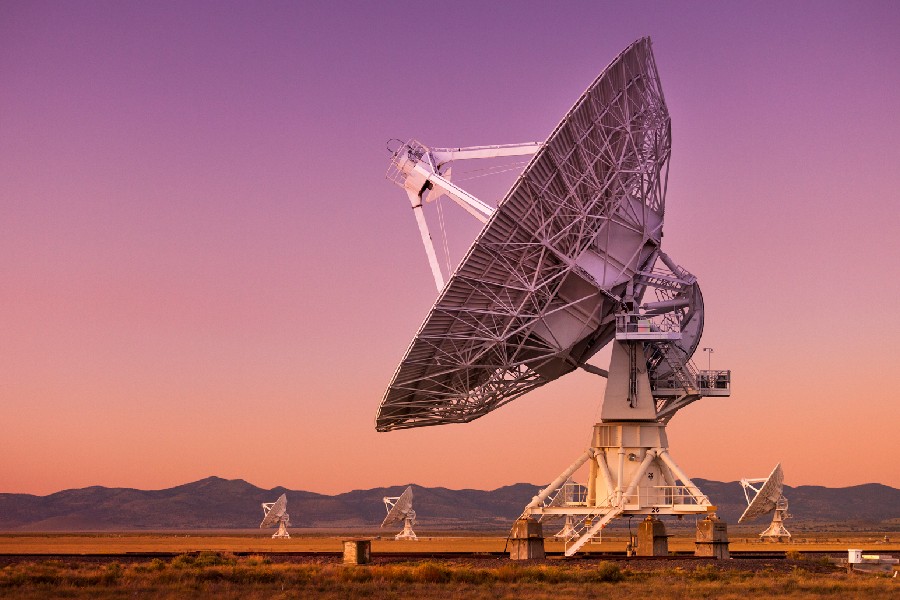Peer deep into the cosmos, and previously invisible worlds open up. Radio waves that permeate space contain untapped information about elusive phenomena. But unlocking secrets from stellar radio signals requires specialized telescopes attuned to these frequencies. How do radio telescopes work? How do these unique telescopes reveal invisible cosmic features?
This article explains the groundbreaking tech enabling investigation of the universe through radio telescopes. We’ll unpack how radio dishes gather stellar radio energy, using antenna anatomy to tune into non-visible phenomena.
Stay tuned as we’ll also explore the groundbreaking technologies enabling investigation of the universe through radio “eyes”. These include dish designs that tune into phenomena beyond visible light and innovations that transform faint signals into discoveries pushing the boundaries of the astronomical frontier.
From engineering that transforms inaudible signals into images of black holes to pioneering tools probing the cosmic microwave background, let’s explore how radio telescope innovations uncover hidden realms.

How Do Radio Telescopes Work?
How do radio telescopes work? Radio telescopes work by using large dish antennas to collect radio wave emissions from celestial objects. As naturally emitted radio waves from space interact with the reflective telescope dish, they are focused into a receiver.
So, what do radio telescopes detect if there is an amplified radio signal?
Advanced signal processing renders capture radiation into a form that reveals information on the physics and properties of cosmic radio sources. These include pulsars, quasars, supernova remnants, and more energetic phenomena.
Radio telescope technology allows astronomers to study energetic phenomena through their faint radio signatures. Radio waves permeate clouds and gasses that visible light cannot penetrate. Radio telescopes open new cosmic vistas invisible by other means.
Significance in Astronomy
Radio telescopes showcase breathtaking nebulae glowing across spectral bands. They reveal remnants of exploded stars and tornadoes on the Sun. Clear radio views through dense dust expose nurseries, birthing new stars.
Radio observatories peer through gas and clouds opaque to visible light. This exposes stellar corpses like pulsars feeding black holes. Radio astronomy provides distinct vision and new discoveries, exposing mechanisms energizing stars, galaxies, and the cosmos.
Radio telescopes enable historic discoveries like quasars, neutron stars, and the cosmic microwave background. Their data unpacks galaxy structure and evolution over cosmic time. Radio observatories showcase sublime celestial engines powering immense jets near supermassive black holes.
What Is the Function of a Radio Telescope?
Fundamental purpose
Detecting radio light
So, what are radio telescopes used for? The fundamental purpose of radio telescopes is to detect faint radio light emitted naturally from cosmic objects. Many celestial bodies like stars, gasses, galaxies, and more radiate detectable radio waves. Special antennas collect and concentrate these long radio waves for analysis.
Radio telescopes are specifically engineered to gather the radio energy released by the universe. Specialized radio antennas focus this cosmic radio radiation into receivers for interpretation. This enables studying stellar processes through their radio emissions.
Studying emissions
Many stellar phenomena generate radio energy spanning long wavelengths – some solely radiate at radio bands. Radio observatories focus specifically on interpreting faint natural radio emissions coming from the universe.
As stars, galaxies, and gasses energize, accelerate particles, spin, and magnetically flux, they release non-thermal radio waves. Radio astronomers study the information encoded in measurable radio signals using physics and analysis techniques.
Detailed study of cosmic radio emissions over time maps stellar magnetic fields, energetic jets, cold gas structures, and more through this window.

Expanding understanding
Analyzing these radio signals over time reveals details about the physics and behaviors of radio-bright celestial bodies. This expands our understanding of energetic processes powering the cosmos.
Phenomena like pulsars, quasars, supernovae, protostars, and cosmic rays shine at radio frequencies, signaling their extreme physics. Data helps us understand and create models of energetic astrophysical processes.
As an accretion disk spirals around a feeding supermassive black hole, radio jets shoot, exposing gravity’s shocking grip – this storyline emerges from radio signals alone.
Role in astronomy
Peer into invisible
Radio observations peer through dense gas and dust opaque to visible light, revealing galactic features hidden otherwise as stellar nurseries cocooned in clouds. Radio astronomy explores invisible realms.
Radio light penetrates the thick cosmic fog, masking birthing star clusters and feeding black holes. Radio telescopes showcase cosmic engines behind the dust, exposing stellar tickings.
Clear radio views unveil cold molecular clouds, supernova remnants and more stellar phenomena enshrouded at visual wavelengths. Radio waves can penetrate barriers that obstruct our vision, allowing us to see beyond what is visible.
New discoveries
Historic discoveries like quasars, pulsars and cosmic microwave background radiation stem from radio data. Radio telescopes provided the first evidence for black holes and dark matter through radio observations as well.
Quasars, rapidly spinning neutron stars, remnants of the Big Bang itself – these breakthroughs emerged solely through radio astronomy – a distinct vision exposing unseen frontiers.
Cosmic microwave background measurements proved the Big Bang model. Dark matter’s hidden gravity was first mapped in radio views of spinning galaxies. Radio spotlighted black holes before optical confirmation.
Complementary vision
Combining visible and infrared information with radio views provides comprehensive insight into cosmic workings. Radio data gives context to better interpret visual images. Together, multiwavelength observations paint a richer portrait of our dynamic universe.
A nebula glows across infrared, optical, and radio maps – each spectrum highlights different structures, providing context to decode its stellar engine.
Radio waves permeate the light-blocking obstacles, dimming shorter wavelengths – leveraging radio’s penetration exposes obscured stars and galaxies for more holistic understanding fused through the spectrum.

History of Radio Telescopes
Development timeline
Early discoveries
In 1932, Bell Telephone engineer Karl Jansky detected radio hiss from the galaxy’s center at 14.6m Hz, founding radio astronomy. Grote Reber built the first radio telescope in 1937 to systematically map sky brightness. Radio light revealed new science about cosmic workings early on.
Post WWII advances
After WWII, surplus military radars were converted into steerable dishes detecting extraterrestrial radio signals – opening radio astronomy’s potential.
New arrays achieved higher sensitivity and resolution imaging distant quasars, pulsars, and galaxies, unveiling extreme physics. This substantially expanded our cosmic understanding through this fresh vision.
Modern era
Today international collaborations construct huge radio facilities like ALMA, FAST, MeerKAT, and SKA, pushing detection boundaries ever deeper toward tracing cosmic origins. This showcases astronomy’s expanding frontiers enabled by relentless innovation.
Notable innovations
Electronics and computing
Advancing electronics since the 1970’s enabled amplifying faint celestial signals for analysis, reconstructing noise into images. Computing revolution increased speed processing abundant radio data into discoveries – innovating electronics and algorithms fueled growth.
Interferometry
Interferometry combines multiple dishes functioning like one giant sharp telescope rendering ultra-high resolution radio views previously impossible. Interferometry visualization pierced new cosmic sightlines and dimensions.
Components of a Radio Telescope
Parabolic dishes
Radio collectors
The parabolic dish collects and concentrates faint radio waves to a focal point for detection and analysis. The oversized curved shape bounces diffuse signals to a central receiver.
Giant antennas enhance gain for detecting cosmic radio sources across the universe. Bigger dishes collect more radio energy focused into the receiver for amplification. Dish diameter directly impacts telescope resolution.
Radio focusing
Geometry focuses wide bandwidths onto a small receiver, magnifying the collecting area. The angled dish reflects waves precisely to the focal point like a specialized radio mirror.
Curved dishes biologically resemble a deer’s large outer ear anatomy used for sound collection – an ideal natural radio antenna reused for astronomical purposes.
Enhancing sensitivity
Increasing dish size expands the radio gathering area to boost faint signals from cold gasses. 30-meter class radio telescopes now explore details within galaxies.
The larger the parabola, the higher the gain and sensitivity to map radio emissions across the cosmos. Expanding the fundamental dish resolution enables new science.

Receivers and amplifiers
Signal catchers
The receiver at the focal point detects weak waves using sensitive, cryogenically-cooled amplifiers just above absolute zero. This specialized system captures cosmic radio whispers.
A radio receiver works like a digital camera sensor. It translates high-frequency radio photons, or tiny energy particles, into low-frequency electrical bits that computers can process. This retains the encoded information patterns present in the original radio signals.
Signal boosters
Ultra-low noise amplifiers provide tremendous gain essential for identifying faint patterns in nanowatt signals from space. Reducing thermal noise distortions uncovered new science.
Boosting signals enables analysis of astrophysical information within radio emissions. High performance electronics specially designed to minimize distortions are necessary to boost waves.
Signal conversion
Digitizing signals enables advanced computing for enhanced analysis and optimized sampling revealing transient event behaviors.
Converted signals undergo amplification, filtration, and processing to decode the message from space. Retaining frequency phase information allows reconstructing images from noise.
Computer control systems
Process optimization
Central automation handles configuration tuning and calibration for optimizing telescope observations. Computational controllers also orchestrate equipment cascades for precision data collection.
Warning thresholds monitor system health like pointing accuracy, detecting potential faults impacting measures – allowing preventative intervention for reliability.
Enhanced efficiency
Remote web interfaces enable efficient scriptable control for members. This helps maximize scientific use by queues cascading nightly observations.
Parallel processing hides complexity. This powers abundant data collection since the universe’s reionization epoch. That was when galaxies first ignited.
Conclusion
Through this explanation on astronomical facilities, we hope you have a clearer picture of how do radio telescopes work and unveil the universe. By using the intrinsic technology of radio antennas and signals combined with advanced electronics and computing, radio observatories expose unseen stellar phenomena.
We explored how precision dish engineering enables detection of faint cosmic radio emissions from space. From historic milestones to current mega projects pushing boundaries of scale, innovative developments in how do radio telescopes work consistently expand and enrich our vision.
Continued progression in radio technology beckons deeper understanding of the processes powering stars and galaxies across cosmic time.
As our technology advances and we can hear more, what insights might newly audible signals whisper from hidden corners of space or even alien engineers? Exploring ways to expand the cosmic messages radio telescopes receive will shape discoveries yet unforeseen.
